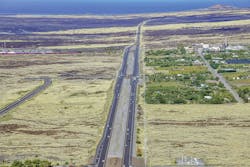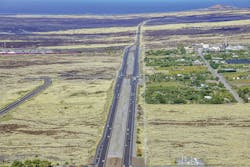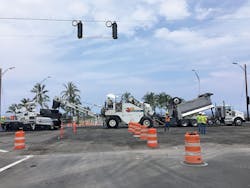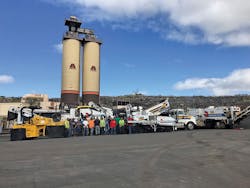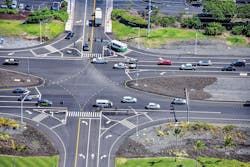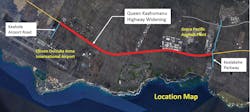By: Jon M. Young
Three years after breaking ground and more than 10 years since the Hawaii Department of Transportation (HDOT) first awarded the bid, the second phase of the Queen Kaahumanu Highway Widening was completed late last year.
The $128 million project, which widened Queen Kaahumanu Highway, from Kealakehe Parkway to Keahole Airport Road, from two lanes to four lanes, was accomplished as a design-build project. In addition to the widening of the road, the effort resulted in six new signalized intersections, drainage systems, utility relocations, safety features such as guardrails and medians, and landscaping befitting the location of the highway, as well as 4.5 miles of new water lines. The project also included a new sewer system to move wastewater from regional developments to the Kealakehe Wastewater Treatment Plant and an R-1 line to bring back treated water.
The design-build team was led by general contractor Goodfellow Bros. Inc. (GBI). Several Hawaii Asphalt Paving Industry members contributed to the success of the project as well. Grace Pacific LLC was the asphalt paving subcontractor; SSFM International Inc. (SSFM) contributed as the design project manager as well as civil and structural engineer; and R. M. Towill Corp. served as the construction manager.
North End of completed project showing the Queen Kaahumanu Highway from OTEC Road (bottom of picture), Kaiminani Drive intersection (center), and Keahole Airport Road intersection (top).
A long time coming
The project has a long history dating back to July 2008 when bids were first opened. The project faced many obstacles, such as several bid protests, a protracted Section 106 consultation process, and delays during construction.
After multiple protests and rebids, the design-build project was finally awarded to GBI. In July 2010, HDOT gave GBI a notice to proceed with the design, with a goal of starting construction in early 2011.
However, construction did not start as anticipated. On Oct. 26, 2011, officials from HDOT and GBI were at Kealakehe High School to give an update on the Queen Kaahumanu Highway widening project, Phase 2. At the meeting, HDOT believed the construction would start in early 2012, but that would not be the case.
The discovery of previously unknown historic sites, including burials and human remains, required reopening the Section 106 consultation process and evaluation of Section 4(f) avoidance and mitigation.
The Section 106 review process is an integral component of the National Historic Preservation Act (NHPA) of 1966. Prior to the NHPA being enacted, it was not uncommon for nationally significant historic resources to be irreversibly damaged or destroyed by many federal undertakings. Section 106 of the NHPA requires each federal agency to identify and assess the effects their actions will have on historic resources. The process requires each federal agency to consider public views and concerns about historic preservation issues when making final project decisions. The goal of Section 106 is to seek agreement among these participants regarding preservation matters arising during the review process.
Crews paved the 6-in. ATB lift on the new southbound lanes at the Keahole Airport Road intersection in July 2017.
Section 4(f) of the U.S. DOT Act of 1966 prohibits the Federal Transit Administration (FTA) and other U.S. DOT agencies from using land from publicly owned parks, recreation areas (including recreational trails), wildlife and water fowl refuges, or public and private historic properties, unless there is no feasible and prudent alternative to that use and the action includes all possible planning to minimize harm to the property resulting from such use.
The protracted Section 106 and 4(f) process and consultations were time-consuming, as the interests of many different agencies and advocacy groups, including Native Hawaiian Organizations and the National Park Service, needed to be considered to agree on a path forward. It delayed the start of construction until September 2015. During construction, there were two major issues related to the Section 106 evaluation that cropped up, resulting in the overall completion date to slip a further five months.
The first delay resulted from the need to redesign the project’s southern segment. The National Park Service and several Native Hawaiian organizations expressed concerns about archaeological sites in the Kaloko-Honokohau National Park during the Section 106 consultations. As a result, HDOT had to shift a portion of the widened highway to reduce the footprint of the roadway. The redesign was not complete by the time the mass excavation work was nearly finished, which resulted in a one-month project slowdown between May and June 2016.
A further delay occurred in July 2016. HDOT identified several breaches of two trails that were listed on the State Inventory of Historic Places. HDOT also discovered the area of potential effect did not include connections to the adjoining roads. Construction of the project continued, albeit at a slower pace, until September 2016 when the work stopped. The combination of the previously mentioned issues, along with finalizing the design of said connections, delayed construction for four months until Jan. 30, 2017.
The Grace Pacific team at their Kona Asphalt Plant.
Keeping the flow
Aside from these delays, the construction itself went smoothly. GBI conducted weekly and sometimes daily scheduling meetings to proactively work on issues ahead of time to keep the project moving forward.
A major concern for the public was traffic during construction. To minimize this concern, traffic control was set so that at least one lane in each direction remained open at all times. The only work requiring temporary lane closures was during construction of the cross-street intersections, utility crossings, final overlay and striping of the southbound lanes, and finishing work that could not be completed because of conflicts with temporary pavements.
The construction did not adversely affect the access and turning movements at existing intersections, as the work was staged such that existing access and turning movements were preserved and opened to traffic. When the new traffic signals were made operational, access and turning movements were allowed and then controlled by the new intersection turning movements.
In addition, HDOT created a website to keep the public updated on the progress of the project during construction. The website was routinely updated every two weeks, often more frequently, to show what work had been completed, what was planned over the coming two-week period and to announce any changes to the traffic control system that was in place. The website also included announcements of interest to the public.
Completed improvements for the Hulikoa Drive intersection provided access to the Kohanaiki Resort and Kohanaiki Industrial areas.
A lot of rock
Paving was accomplished by the placement of just over 117,700 tons of hot-mix asphalt. Approximately 79,400 tons of asphalt-treated base course was placed in 3-in. and 6-in. thicknesses. State Mix IV (similar to Superpave 12.5 mm) served as the surface course. About 38,300 tons was placed in 1.5-in. and 2-in. lifts, respectively.
Grace Pacific incorporated 20% RAP into its mix designs for most of the paving work. The company’s plant is in the vicinity of the project, which negated the challenge of getting material to the worksite. Prior to paving, just over 46,600 tons of the existing road was removed by cold planing at various thicknesses across the length of the site, ranging from 1.5 to 10 in.
The asphalt mixes were delivered to the project by a combination of super-, semi-, and tandem-end dump trucks. All material was dumped into a Roadtec SB-2500 material transfer vehicle (Shuttle Buggy), then unloaded into a Roadtec RP-195 rubber track paver with Carlson Easy Screed EZ IV. The number of trucks varied, but was normally seven to 12 daily depending on the day’s production, haul cycle to work area location, whether crews were paving amidst or without traffic, and whether it was a day or night shift.
To provide a quality pavement, Grace Pacific utilized a grade-control system that is ordinarily used on the earthwork, utilities and grading portions of a construction project, but not typically used in paving operations. The Trimble 3-D grade-control system was used on some of the milling and paving portions of work on the existing highway. Use of this system resulted in a smooth riding pavement. The 3-D machine-control systems put the design surfaces, grades and alignments inside the cab, giving operators control over cold planing and paving. Using CAD, SSFM worked with Grace Pacific to develop the 3-D milling design used for the resurfacing portion of the project.
The process started with a conference call between SSFM, GBI and Sitech/Trimble in December 2017. The focus of the call was to discuss what information would be needed for the machines to be able to accurately interpret the 3-D model into milling depths. SSFM completed the design, and the first test run was done in mid-January 2018. The test was a success; the cold-plane machines achieved elevations within hundredths of an inch. Based on the results, Grace Pacific proceeded to complete their cold-planing operations.
A major factor that contributed to the success of the project was the working relationship developed between HDOT Highways Division (the project owner), Goodfellow Bros. Inc. and its subcontractors, and various engineering consultants. This project was a team effort that resulted in the project staying on schedule and meeting the required high standards.
“This team, our work family, has taken on lots of obstacles and has endured tough hurdles,” said Ed Brown, Hawaii vice president of operations for GBI. “Regardless of that, we always had the goal to build the best, safest, long-lasting and highest-quality road for the community.”
On Aug. 9, 2018, the community celebrated the opening of the widened highway. Officials participating in the ceremonial untying of the maile lei included Gov. David Ige, Kahu Daniel Akaka Jr., Hawaii County Managing Director Wil Okabe, Sen. Lorraine Inouye, Rep. Nicole Lowen and Rep. Cindy Evans.
The $128 million Queen Kaahumanu Highway Widening Project was widened from two lanes to four lanes from Kealakehe Parkway to Keahole Airport Road.
About The Author: Young is executive director of the Hawaii Asphalt Paving Industry.
